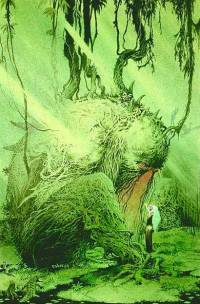 Home > CR Reviews
Home > CR Reviews Drawing Down The Moon
posted August 5, 2010
Drawing Down The Moon
posted August 5, 2010

 Creators:
Creators: Charles Vess, Susanna Clarke
Publishing Information: Dark Horse, hardcover, 200 pages, January 2010, $39.99
Ordering Numbers: 9781593078133 (ISBN13), 1593078137 (ISBN10)
Not only am I vastly unqualified to speak of Charles Vess' art from a technical or aesthetic viewpoint,
Drawing Down The Moon is one of those few art books where the introduction -- by the fantasy novelist Susanna Clarke -- contains enough idiosyncratic, quality observation from the reader's standpoint that you're constantly checking off subject matter you might engage were you not now slightly intimidated to do so. What I have left may or may not constitute a solid review but it will be honest and my own. I should start by saying that I'm not a natural fan of Vess, or at least once thought myself not as much of a fan as I think I am now. During the years I devoured fantasy literature and visual art both classic and furtively derivative I was something of a high adventure kid. My favorite fantasies involved leaving home the very first thing and heading someplace grand, mighty and transformational. Vess always seemed to me a backyard fantasy guy, the person who led folks into fairy lands 200 yards away from one's own bedroom door. It's only as I've become older that I've been able to appreciate those kinds of stories as much as the Campbell-style journey.
 Drawing Down The Moon
Drawing Down The Moon takes on the breadth of Vess' career, from early art (his student work was comics-ready) through the mix of high-profile gigs and things like sculpture or work related to the theater that occupies most of his time now. One thing that comes through, and this may just be the curated nature of the book, is that Vess has done a fine job managing his career. He has played to his strengths and indulged his interests in a way that has consistently flattered what he does well. There's not a whole lot of work where I've thought the match of artist to material was a bad one: of the big-name material included here, his work for George RR Martin's books intrigued me by far the least. I think what might be considered good fortune is deliberate; Vess has remained active enough in terms of seeking out work or doing work of his own that he's either allowed to cherry pick what gets offered to him or, perhaps, no one bothers him unless it's something that seems super-appropriate to his skill set.
What are his skills? That's the fun part of digging into his book. For instance, I think it's a much-too-easy observation to say that there's a theatrical quality to a lot of Vess' comics. Not only are works like those from Shakespeare he adapted with Neil Gaiman for use in
Sandman and the great children's stageplay
Peter Pan present throughout his career, Vess's art, more than others, offers the virtues familiar to the stage: the way he opens up and presents a tableau, for instance. This may be most strongly on display in a recurring visual element of a person or people walking into moment -- sometimes a fantastic element entering the ordinary world, sometimes an innocent entering a fantasy, and sometimes one or the other exploring the area in between. Vess has a veteran director's understanding of the energy of the stage, the way an audience strains forward and desires to figure out what's being presented to them, their sensitivity to introduced elements, and how this invests a still figure or even a competing one with a certain amount of power in reserve. One of the reasons why an early story using Jack Kirby's Warriors Three characters works so well when other post-Kirby comics haven't is that Vess embraces the character design but doesn't try to replicate Kirby's staggering reserve of cosmic energy. It's clearly a choice: a few Spider-Man images in the book indicate that Vess knows how to rev things up the Marvel Way when he wants to. Volstagg in particular seems to be played by an actor borrowed from The Globe rather than someone torn from an old comic book or even a Hal Foster-style single page. When Clarke marvels at the mix of lively and decorative elements in Vess' drawing, I would suggest it's his ability to stage scenes that makes this possible, the focus on the figure -- or several of them -- and an open invitation to figure out its meaning on our own.
Drawing Down The Moon is a well-produced book, although nothing here is likely to drop jaws in this day and age of consistently excellent production and design. The interior art reproductions seem to me first-rate -- granted, I have the worst eye of all of my friends in comics -- although I'll admit that the cover is somewhat of a personal disappointment in that I would have maybe liked a different texture to the image placed there as that distinguished it from what's to come. The overlays making up the chapter headers are handsome but aren't show-stopper I imagine was hoped for them -- in fact, they break from the consistency of the other page in a way that may warp the interior pages slightly within the sturdy hardcover.
Drawing Down The Moon is limited to a number of copies and my understanding is it won't be reprinted.



